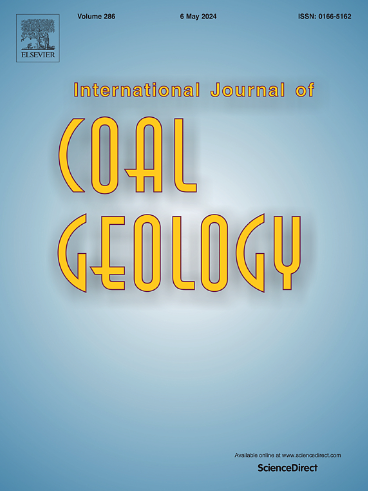哥伦比亚安第斯山脉东部Cordillera盆地白垩系-古近系亚烟煤和烟煤的FTIR光谱特征:煤化过程中分子结构演化的启示
IF 5.7
2区 工程技术
Q2 ENERGY & FUELS
引用次数: 0
摘要
煤化过程和矿物组成影响着有机质的分子结构,但它们的精确作用仍然是煤地质研究的一个重大挑战。本次研究的重点是哥伦比亚安第斯山脉白垩纪-古近纪瓜多瓦斯组的亚烟煤和烟煤,同时建立了包含118个样品的广泛的红外光谱特征数据库。本研究采用的分析技术包括中红外区傅立叶变换红外光谱(FTIR-MIR),使用KBr颗粒法,微傅立叶变换红外光谱和x射线衍射(XRD)。测定了分子结构参数,如芳香度(AR1和AR2)、缩合度(DOC1和DOC2)、亚甲基比(CH2/CH3)和因子A。研究样品的随机镜质组反射率(VRr%)在0.46 % ~ 1.65 %之间,表明存在亚烟煤和烟煤。结果表明:AR1范围为0.026 ~ 0.182,AR2范围为0.208 ~ 1.282,DOC1范围为0.048 ~ 0.244,DOC2范围为0.373 ~ 1.797,CH2/CH3范围为2.444 ~ 6.430,因子A范围为0.559 ~ 0.701。红外光谱中有明显的无机峰,与煤矿物相吻合,以高岭石和石英为主,菱铁矿、黄铁矿和氧化铁少量出现。显微ftir数据表明,与镜质组和脂质组相比,惰质组的显微组分具有更高的芳构性和缩聚性。结构参数的相关性表明,随着VRr%的增加(或煤阶的增加),缩聚和芳香性增加。芳香性和凝结性随深度增加而增加,说明埋藏作用影响了瓜达斯组煤的等级。惰性煤含量越高,煤的芳烃/缩合度越高,脂肪链长度(CH2/CH3)越短。分析数据的FTIR光谱表明,煤化作用是影响东科迪勒拉盆地煤有机分子结构的主要因素。研究发现,在解释等煤中观察到的分子结构参数的变化时,矿物组成也是至关重要的。从这个意义上说,富脂质组煤富集脂肪组分,而富镜质组煤和富惰质组煤富集芳香族化合物,表现出易气特征。本文章由计算机程序翻译,如有差异,请以英文原文为准。
FTIR spectral signatures of Cretaceous-Paleogene sub-bituminous and bituminous coal: Insights into molecular structure evolution during coalification in the Eastern Cordillera Basin, Colombian Andes
The coalification process and maceral composition influence the molecular structure of the organic matter, yet their precise effects remain a significant challenge in coal geology studies. This investigation focused on sub-bituminous and bituminous coal from the Cretaceous-Paleogene Guaduas Formation in the Colombian Andes, concurrently creating an extensive database of FTIR spectral signatures with 118 samples. Analytical techniques employed in this study included Fourier Transform Infrared spectroscopy in the mid-Infrared Region (FTIR-MIR) using the KBr pellet method, micro-FTIR spectroscopy, and X-ray diffraction (XRD). Molecular structural parameters, such as Aromaticity (AR1 and AR2), Degree of Condensation (DOC1 and DOC2), methylene-to-methyl ratio (CH2/CH3), and Factor A, were determined. The random vitrinite reflectance (VRr%) of the studied samples ranged from 0.46 % to 1.65 %, indicating the occurrence of sub-bituminous and bituminous coals. The results revealed AR1 ranging from 0.026 to 0.182, AR2 from 0.208 to 1.282, DOC1 from 0.048 to 0.244, DOC2 from 0.373 to 1.797, CH2/CH3 from 2.444 to 6.430, and Factor A from 0.559 to 0.701. The prominent inorganic peaks in the FTIR spectra corroborated with the coal mineralogy, kaolinite and quartz, which are dominant, with minor occurrences of siderite, pyrite, and iron oxides. Micro-FTIR data indicated higher aromaticity and condensation in macerals of the inertinite group compared to vitrinite and liptinite groups. The correlation of structural parameters showed an increase in condensation and aromaticity with higher VRr% (or increased coal rank). The aromaticity and condensation increased with depth, suggesting that burial affected the rank of the Guaduas Formation coal. Coal with a higher inertinite content showed higher aromaticity/condensation and shorter aliphatic chain length (CH2/CH3). The FTIR spectra of the analyzed dataset reveal that coalification was the dominant factor that affected the organic molecular structure of coal in the Eastern Cordillera Basin. It was found that maceral composition is also crucial in explaining the variations in molecular structural parameters observed in isorank coals. In this sense, liptinite-rich coal was enriched in aliphatic components, whereas vitrinite and inertinite-rich coals were enriched in aromatic compounds, exhibiting gas-prone characteristics.
求助全文
通过发布文献求助,成功后即可免费获取论文全文。
去求助
来源期刊

International Journal of Coal Geology
工程技术-地球科学综合
CiteScore
11.00
自引率
14.30%
发文量
145
审稿时长
38 days
期刊介绍:
The International Journal of Coal Geology deals with fundamental and applied aspects of the geology and petrology of coal, oil/gas source rocks and shale gas resources. The journal aims to advance the exploration, exploitation and utilization of these resources, and to stimulate environmental awareness as well as advancement of engineering for effective resource management.
 求助内容:
求助内容: 应助结果提醒方式:
应助结果提醒方式:


